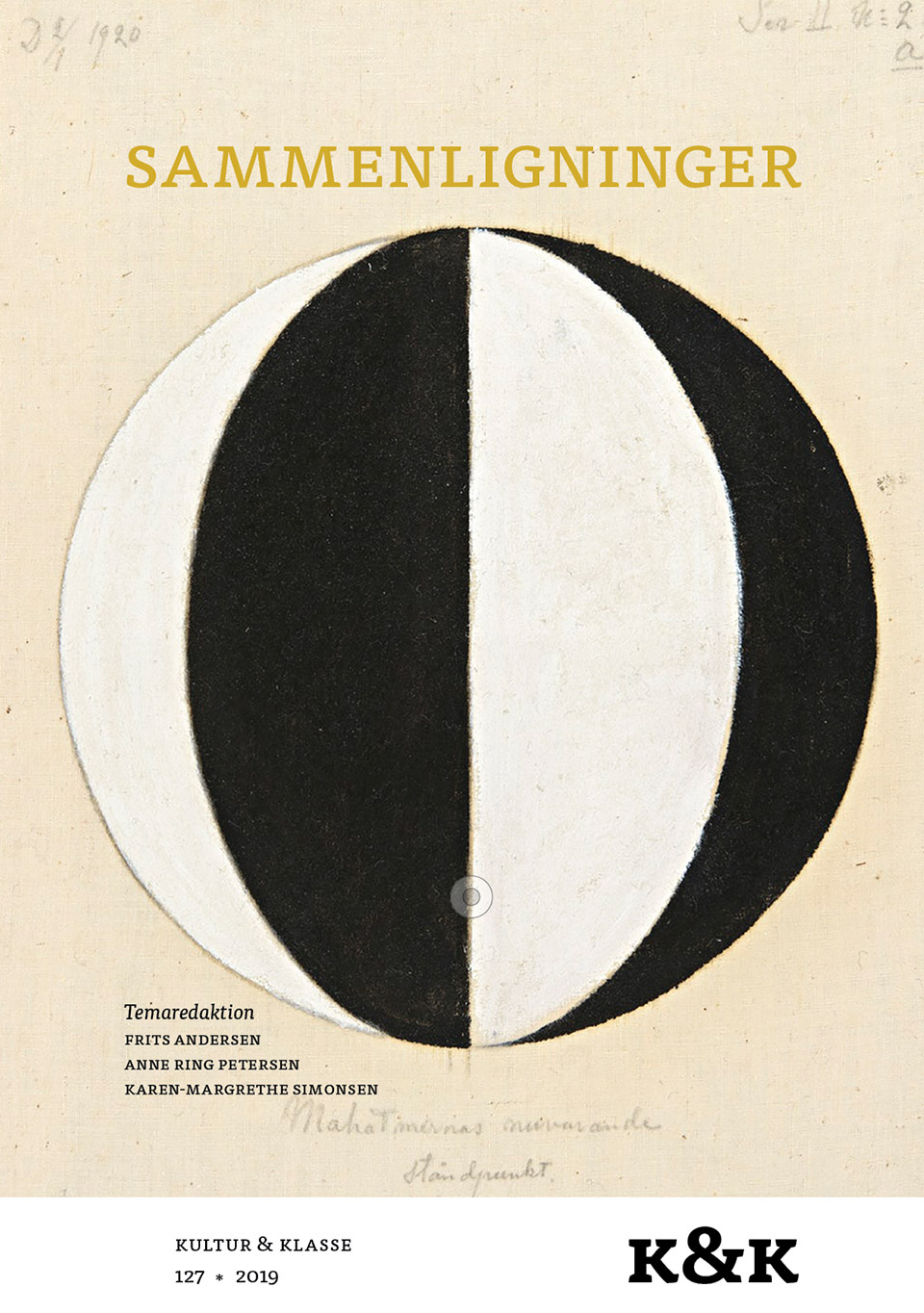”Qui est Dominique Lambert?”
Sammenligning og virtualitet
DOI:
https://doi.org/10.7146/kok.v47i127.114744Nøgleord:
sammenligning;virtualitet;databehandling;Stéphanie Solinas;Gilles Deleuze;Resumé
Comparison as a methodological or technical tool to perceive something that was not perceptible beforehand is a complex manoeuvre that gives rise to both potentials and challenges. While emphasising concealed or unseen similarities in artworks or literature, comparison also risks operating on the expense of the potential distance between the two subject matters compared. This article argues that the complex and curious art project Dominique Lambert (2004-2016) by the French artist Stéphanie Solinas offers itself as a valuable starting point for a discussion of a range of meta-theoretical and methodological questions related to ideas of comparison in a broader theoretical framework. The project not only questions how or when a comparison is possible, but also what the nature of comparisons is, and how comparisons are legitimised as such in humanistic knowledge production. Thus, it is the central hypothesis of the article that modes of comparing build upon ideas of virtuality, that is, that the ‘object’ of the comparison is produced as a manoeuvre connecting or relating two previously separated subject matters. Accordingly, Gilles Deleuze’ idea of virtuality is applied in order to understand and discuss prevailing uses of comparison, e.g. in the recent field of Digital Humanities.
Referencer
Apter, Emily. ”Translating Extraction: Archeologies of Knowledge, Data-Mining, Overburden.” Situated knowing: the economies of representations. New York City, 10. maj 2018.
Apter, Emily. ”Untranslatables: A World System.” New Literary History 39 3 (2008): 581-598. doi:10.1353/nlh.0.0055
Berry, David M. ”The computational turn: thinking about the digital humanities.” Culture Machine 12 (2011). Web. 15. april 2019. http://sro.sussex.ac.uk/id/eprint/49813/
Blair, Ann. Too much to know : managing scholarly information before the modern age. New Haven Conn.: Yale University Press, 2010.
Bois, Yve-Alain. ”On the Uses and Abuses of Look-alikes.” October 154 (2015): 127-149. doi:10.1162/OCTO_a_00240
Boyd, Danah og Kate Crawford. ”Six Provocations for Big Data.” A Decade in Internet Time: Symposium on the Dynamics of the Internet and Society. Oxford Internet Institut. 21. september 2011. doi:10.2139/ssrn.1926431
Bryant, Levi R. Difference and Givenness: Deleuze’s Transcendental Empiricism and the Ontology of Immanence. Evanston, Illinois: Northwestern University Press, 2008. doi:10.2307/j.ctv47w5rw
Deleuze, Gilles. Bergsonism. overs. Hugh Tomlinson og Barbara Habberjam. New York: Zone Books, 1988.
Deleuze, Gilles. Desert islands and other texts (1953-1974). overs. Michael Taormina. Cambridge, Mass.: Semiotext(e), 2003.
Diderichsen, Adam et al. Fransk filosofi: engagement og struktur. København: Politikens forlag, 2003.
Felski, Rita og Susan Stanford Friedman. Comparison : theories, approaches, uses. Baltimore, MD: Johns Hopkins University Press, 2013. doi:10.1017/pli.2013.8
FOAM. ”Stéphanie Solinas: Dominique Lambert / Le Pourquoi Pas? 24 February – 16 April 2017.” Amsterdam: FOAM Fotografimuseum, 2016. Web. 15. april 2019. https://www.foam.org/about/press-office/stephanie-solinas
Hills, David. ”Metaphor.” The Standford Encyclopedia of Philosophy. Red. Edward N. Zalta, Stanford: Stanford University Press, 2017. Web. 15. april 2019. https://plato.stanford.edu/entries/metaphor/
Jakobson, Roman. ”To aspekter af sproget og to typer afatisk forstyrrelse.” K&K: Kultur og Klasse. Kritik og Kulturanalyse 22 2 (1995): 47-67.
Mayer-Schönberger, Viktor og Kenneth Cukier. Big data : a revolution that will transform how we live, work and think. London: John Murray, 2013.
Moretti, Franco. Graphs, maps, trees : abstract models for a literary history. London: Verso, 2005.
Panofsky, Erwin og H. W. Janson. Tomb sculpture : four lectures on its changing aspects from Ancient Egypt to Bernini. New York: Harry N. Abrams, 1992.
Rettler, Bradley og Andrew M. Bailey. ”Object.” The Stanford Encyclopedia of Philosophy. Red. Edward N. Zalta, Stanford: Stanford University, 2017. Web. 15. april 2019. https://plato.stanford.edu/entries/object/
Saussure, F. de et al. Course in general linguistics. overs. Wade Baskin, New York: McGraw-Hill, 1966.
Solinas, Stéphanie. Dominique Lambert. Paris & Rencontres d’Arles: RVB Books, 2016.
Spivak, Gayatri Chakravorty. ”Rethinking Comparativism.” New Literary History 40 3 (2009): 609-626. doi:10.1353/nlh.0.0095
van Zundert, Joris J. ”Screwmeneutics and Hermenumericals: The Computationality of Hermeneutics.” A New Companion to Digital Humanities. Red. Susan Schreibman et al. West Sussex: John Wiley & Sons, 2016. 331-347. doi:10.1002/9781118680605.ch23
Downloads
Publiceret
Citation/Eksport
Nummer
Sektion
Licens
Tidsskriftet følger dansk ophavsret.





